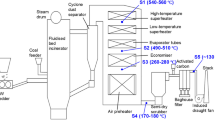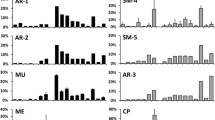Abstract
Domestic waste in China is mainly collected as a combination of different types of materials. The components are variable and complex, with very different combustion characteristics making it difficult to optimize the burning to reduce pollution. There are still some controversies about the accuracy of using carbon monoxide (CO) emission to characterize waste incineration performance. Here, we investigated the relationship between waste classification, incineration conditions and dioxin emission and concluded that the concentration of CO in flue gas could not be used as the only criterion of combustion efficiency and safety. Considering the close relationship between the formation of polychlorinated dibenzo-p-dioxins and dibenzofurans (PCDD/Fs) and products of incomplete combustion, the relatively low concentrations of CO are not a reliable indicator that an incinerator equipped with an activated carbon injection system and fabric filter could achieve the national standards for PCDD/F emission. The goal, therefore, is not only to lower the emission of PCDD/Fs and other pollutants through classifying the waste components at the source, but also to reduce the need for the treatment of incinerated waste to protect the environment and to increase the power generation efficiency of municipal solid waste incineration (MSWI) plants. As the demand for waste disposal continues to rapidly increase, the need for a safe waste incineration system with dioxin emission controls makes the classification of waste an indispensable part of future MSWI systems.
Similar content being viewed by others
Change history
27 August 2021
A Correction to this paper has been published: https://doi.org/10.1007/s42768-021-00078-9
References
Li B, Yan J, Shang N, et al. Study on combustion characteristics of municipal solid waste (MSW). J Fuel Chem Technol. 1998;26:564–8.
Cen K, Ni M, Yan J, et al. Technologies of combustible solid waste to energy. Beijing: Chemical Industry Press; 2016. p. 535.
Liao H, Yao Q. Study on combustion properties of municipal solid waste by TGA. J Fuel Chem Technol. 2001;29:140–3.
Yan T, Zuo Y, Zhang Y, et al. Experimental study on the combustion characteristics of municipal solid waste. J Combust Sci Technol. 2002;8:543–7.
Jin Y. Study on MSW combustion characteristics and a new CFB incineration technology. Zhejiang University; 2002.
Jiang S, Jiao W. The investigation of the city refuse combustion characteristics. J Eng Thermophys. 1998;19:647–51.
Khalfi A, Trouvé G, Delobel R, et al. Correlation of CO and PAH emissions during laboratory-scale incineration of wood waste furnitures. J Anal Appl Pyrol. 2000;56:243–62.
Li CT, Zhuang HK, Hsieh LT, et al. PAH emission from the incineration of three plastic wastes. Environ Int. 2002;27:61–7.
Frenklach M. Production of polycyclic aromatic hydrocarbons in chlorine containing environments. Combust Sci Technol. 1990;74:283–96.
Xing Z. Combustion characteristics of municipal solid waste. Huazhong University of Science & Technology; 2013.
Wang X, Li M, Li H, et al. Stable combustion control and adjustment of municipal solid waste incineration power boiler. Energy Conserv Technol. 2012;30:561–3.
Zhang Y, Zhu XY, Liang HD, et al. Numerical simulation study on bed combustion of high moisture content municipal solid waste. Energy Conserv Technol. 2007;25:391–4.
Dai K. Experimental study on composition variation on waste combustion of a fixed bed. Harbin Institute of Technology; 2007.
Addink R, Cnubben PAJP, Olie K. Formation of polychlorinated dibenzo-p-dioxins/dibenzofurans on fly ash from precursors and carbon model compounds. Carbon. 1995;33:1463–71.
Huang H, Buekens A. On the mechanisms of dioxin formation in combustion processes. Chemosphere. 1995;31:4117.
Stanmore BR. The formation of dioxins in combustion systems. Combust Flame. 2004;136:398–427.
Wang M-S, Chen S-J, Lai Y-C, et al. Characterization of persistent organic pollutants in ash collected from different facilities of a municipal solid waste incinerator. Aerosol Air Qual Res. 2010;10:391–402.
Zhang M, Yang J, Buekens A, et al. PCDD/F catalysis by metal chlorides and oxides. Chemosphere. 2016;159:536–44.
Cheng H, Hu Y. Curbing dioxin emissions from municipal solid waste incineration in China: re-thinking about management policies and practices. Environ Pollut. 2010;158:2809–14.
You X. Polycyclic aromatic hydrocarbon (PAH) emission from co-firing municipal solid waste (MSW) and coal in a fluidized bed incinerator. Waste Manag. 2008;28:1543–51.
Wang T, Chen T, Lin X, et al. Emission and distribution of PCDD/Fs, chlorobenzenes, chlorophenols, and PAHs from stack gas of a fluidized bed and a stoker waste incinerator in China. Environ Sci Pollut Res. 2017;24:5607–18.
Wang T, Tong C, Lin B, et al. Emission characteristics and relationships among PCDD/Fs, chlorobenzenes, chlorophenols and PAHs in the stack gas from two municipal solid waste incinerators in China. Rsc Adv. 2017;7:44309–18.
Kaune A, Lenoir D, Schramm KW, et al. Chlorobenzenes and chlorophenols as indicator parameters for chlorinated dibenzodioxins and dibenzofurans in incineration processes: influences of various facilities and sampling points. Environ Eng Sci. 1998;15:85–95.
Lavric ED, Konnov AA, Ruyck JD. Surrogate compounds for dioxins in incineration. A review. Waste Manag. 2005;25:755–65.
Addink R, Olie K. Mechanisms of formation and destruction of polychlorinated dibenzo-p-dioxins and dibenzofurans in heterogeneous systems. Environ Sci Technol. 1995;29:1425.
Weber R, Iino F, Imagawa T, et al. Formation of PCDF, PCDD, PCB, and PCN in de novo synthesis from PAH: mechanistic aspects and correlation to fluidized bed incinerators. Chemosphere. 2001;44:1429–38.
Roland W, Takeshi S, Shunichiro U, et al. Correlation of PCDD/PCDF and CO values in a MSW incinerator–indication of memory effects in the high temperature/cooling section. Chemosphere. 2002;49:127–34.
Zimmermann R, Blumenstock M, Heger HJ, et al. Emission of nonchlorinated and chlorinated aromatics in the flue gas of incineration plants during and after transient disturbances of combustion conditions: delayed emission effects. Environ Sci Technol. 2001;35:1019–30.
Wikström E, Löfvenius G, Rappe C, et al. Influence of level and form of chlorine on the formation of chlorinated dioxins, dibenzofurans, and benzenes during combustion of an artificial fuel in a laboratory reactor. Environ Sci Technol. 1996;30:1637–44.
Halonen I, Tarhanen J, Kopsa T, et al. Formation of polychlorinated dioxins and dibenzofurans in incineration of refuse derived fuel and biosludge. Chemosphere. 1993;26:1869–80.
Hatanaka T, Imagawa T, Takeuchi M. Formation of PCDD/Fs in artificial solid waste incineration in a laboratory-scale fluidized-bed reactor: influence of contents and forms of chlorine sources in high-temperature combustion. Environ Sci Technol. 2000;34:3920–4.
Yasuhara A, Katami T, Okuda T, et al. Formation of dioxins during the combustion of newspapers in the presence of sodium chloride and poly(vinyl chloride). Environ Sci Technol. 2001;35:1373–8.
Kolenda J, Gass H, Wilken M, et al. Determination and reduction of PCDD/F emissions from wood burning facilities. Chemosphere. 1994;29:1927–38.
Chin Y-T, Lin C, Chang-Chien G-P, et al. PCDD/F formation catalyzed by the metal chlorides and chlorinated aromatic compounds in fly ash. Aerosol Air Qual Res. 2012;12:228–36.
Takashi F, Masaki T, Nobuo T. Influence of Cu, Fe, Pb, and Zn chlorides and oxides on formation of chlorinated aromatic compounds in MSWI fly ash. Environ Sci Technol. 2009;43:8053–9.
Takeshi H, Akio K, Masao T. Role of copper chloride in the formation of polychlorinated dibenzo-p-dioxins and dibenzofurans during incineration. Chemosphere. 2004;57:73–9.
Ma W, Hoffmann G, Schirmer M, et al. Chlorine characterization and thermal behavior in MSW and RDF. J Hazard Mater. 2010;178:489–98.
Mi Y. Inhibition of PCDD/Fs formation during medical waste incineration and research of environmental impact of incinerator. Zhejiang University; 2012.
Buekens A, Huang H. Comparative evaluation of techniques for controlling the formation and emission of chlorinated dioxins/furans in municipal waste incineration. J Hazard Mater. 1998;62:1–33.
Long YY, Shen DS, Wang HT, et al. Heavy metal source analysis in municipal solid waste (MSW): case study on Cu and Zn. J Hazard Mater. 2011;186:1082–7.
Shi DZ, Wu WX, Lu SY, et al. Effect of MSW source-classified collection on the emission of PCDDs/Fs and heavy metals from incineration in China. J Hazard Mater. 2008;153:685–94.
Ministry of Environment of Japan. White Book of Environment; White Book of Circulating Society; White Book of Biodiversity. 2012.
Acknowledgements
This study was supported by the National Natural Science Foundation of China (51621005), and the National Key Research and Development Program of China (2017YFC0703100).
Author information
Authors and Affiliations
Corresponding author
Additional information
Publisher's Note
Springer Nature remains neutral with regard to jurisdictional claims in published maps and institutional affiliations.
Rights and permissions
About this article
Cite this article
Li, X., Ma, Y., Zhang, M. et al. Study on the relationship between waste classification, combustion condition and dioxin emission from waste incineration. Waste Dispos. Sustain. Energy 1, 91–98 (2019). https://doi.org/10.1007/s42768-019-00009-9
Received:
Revised:
Accepted:
Published:
Issue Date:
DOI: https://doi.org/10.1007/s42768-019-00009-9








